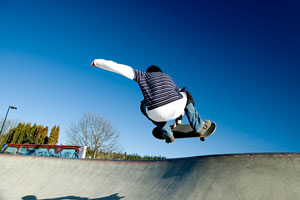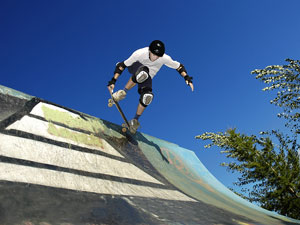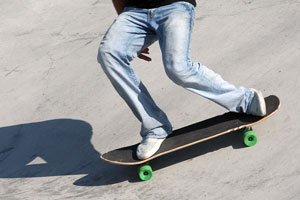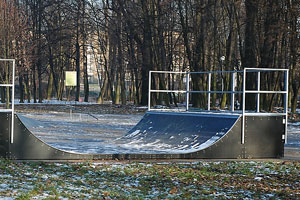
Skateboarding
Sports Information Menu |
|---|
| Archery • Baseball • Basketball • Bowling • Cycling |
| Football • Golf • Hockey • Lacrosse • Paintball |
| Racquetball • Rock Climbing • Scuba Diving |
| Skateboarding • Skating • Skiing • Soccer |
| Softball • Squash • Surfing • Tennis • Volleyball |
 Skateboarding involves riding on a specifically designed four-wheeled
wooden board. It currently draws an estimated 12.5 million riders
worldwide. The sport emerged in California during the 1950s as an
offshoot of surfing, and was originally known as "sidewalk surfing."
Skateboarding went mainstream in the mid 1960s when surfboard
manufacturers such as Hobie and Makata started to build skateboards
resembling small surfboards. They also assembled teams to promote
their products. By 1965, international championships were being
broadcast on national television. Between 1966 and the early 1970s,
popularity of the sport had dropped off, but it was revitalized again by
skaters such as the "Z Boys," who invented vertical skating in swimming
pools left dry from the California drought of 1976.
Skateboarding involves riding on a specifically designed four-wheeled
wooden board. It currently draws an estimated 12.5 million riders
worldwide. The sport emerged in California during the 1950s as an
offshoot of surfing, and was originally known as "sidewalk surfing."
Skateboarding went mainstream in the mid 1960s when surfboard
manufacturers such as Hobie and Makata started to build skateboards
resembling small surfboards. They also assembled teams to promote
their products. By 1965, international championships were being
broadcast on national television. Between 1966 and the early 1970s,
popularity of the sport had dropped off, but it was revitalized again by
skaters such as the "Z Boys," who invented vertical skating in swimming
pools left dry from the California drought of 1976.
Recent Skateboarding News
- Tony Hawk skates his way into 'Nutcracker' for San Diego show: 'You just have to say yes'
Skateboarding legend Tony Hawk over the weekend faced an experience 'WAY outside' his comfort zone: performing in the 'Nutcracker' ballet.
Alexandra Del Rosario. Los Angeles Times. Monday, 22 Dec 2025 21:16:22 GMT. - Extremist Ukrainian database Mirotvorets doxes chiefs of two Russian sports federations
The sports officials at the issue are President of the Russian Judo Federation Sergey Soloveichik and President of the Russian Skateboarding Federation Ilya Vdovin
Tass. Monday, 15 Dec 2025 02:45:33 +0300.
 A skateboard consists of four wheels attached to two axles called
trucks. The trucks are mounted to the bottom of a wooden board
called a deck. Skateboard decks are usually made of seven layers of
pressed Canadian maple veneer; these decks measure 31 inches long and 8
inches wide, featuring a rise at both ends. The front rise is called
a kicknose; the back a kicktail. The kicknose and kicktail provide
leverage for boarders to perform tricks. The deck is usually topped
with abrasive grip tape for traction. A truck is made of a base
plate mounted to the deck and a hanger housing the axle. They are
mounted 13 to 15 inches apart and made of lightweight aluminum, allowing
the riders to shift weight and turn the skateboard. The urethane
wheels on a skateboard are 50 to 65 mm in diameter and 65 mm wide.
Protective equipment includes kneepads, elbow pads, wrist guards, gloves,
and a helmet.
A skateboard consists of four wheels attached to two axles called
trucks. The trucks are mounted to the bottom of a wooden board
called a deck. Skateboard decks are usually made of seven layers of
pressed Canadian maple veneer; these decks measure 31 inches long and 8
inches wide, featuring a rise at both ends. The front rise is called
a kicknose; the back a kicktail. The kicknose and kicktail provide
leverage for boarders to perform tricks. The deck is usually topped
with abrasive grip tape for traction. A truck is made of a base
plate mounted to the deck and a hanger housing the axle. They are
mounted 13 to 15 inches apart and made of lightweight aluminum, allowing
the riders to shift weight and turn the skateboard. The urethane
wheels on a skateboard are 50 to 65 mm in diameter and 65 mm wide.
Protective equipment includes kneepads, elbow pads, wrist guards, gloves,
and a helmet.
 When riding, both feet are shoulder-width apart on the board. The
rider may keep the front foot on the board while using the rear foot to
push off the ground for increased speed. The board is turned by
shifting body weight between toe and heel. A wheelie is performed
by placing weight on the kicktail, and a kick turn is performed while
rotating the board during a wheelie. Aerials are advanced maneuvers
performed by grabbing the side of the skateboard in the air after
launching off a ramp or similar object. An ollie is an aerial stunt
in which the skater does not grab the board while in flight. When
the skater lands back on the board after it has flipped one or more times
while airborne, this is called a board flip. A grind is performed
when one or more trucks is directed onto a curb, railing, pipe, or similar
object, and the rider "rides" this object along the edge.
When riding, both feet are shoulder-width apart on the board. The
rider may keep the front foot on the board while using the rear foot to
push off the ground for increased speed. The board is turned by
shifting body weight between toe and heel. A wheelie is performed
by placing weight on the kicktail, and a kick turn is performed while
rotating the board during a wheelie. Aerials are advanced maneuvers
performed by grabbing the side of the skateboard in the air after
launching off a ramp or similar object. An ollie is an aerial stunt
in which the skater does not grab the board while in flight. When
the skater lands back on the board after it has flipped one or more times
while airborne, this is called a board flip. A grind is performed
when one or more trucks is directed onto a curb, railing, pipe, or similar
object, and the rider "rides" this object along the edge.
 Many cities have skate parks which provide an enclosed environment with ramps, ledges, stairs, and half pipes for skaters to practice their tricks.
Half-pipes are shaped like a trough, and allow riders to practice vertical, or "vert" skating.
In vert skating, riders perform aerial tricks on each end of the pipe, as well as hand plants, foot plants, and flips.
Many cities have skate parks which provide an enclosed environment with ramps, ledges, stairs, and half pipes for skaters to practice their tricks.
Half-pipes are shaped like a trough, and allow riders to practice vertical, or "vert" skating.
In vert skating, riders perform aerial tricks on each end of the pipe, as well as hand plants, foot plants, and flips.
Skateboarding competitions include freestyle, street, and vert categories. In freestyle competition, the skater must perform stunts and tricks on a flat surface. Curbs, benches, stairs, handrails, boxes, and ramps are used in street competition. Large half pipes or empty swimming pools are used in vert competition. Some competitions also include slalom racing, in which skaters must maneuver through an obstacle course.
Skateboarding Information Resource
All rights reserved. About Us.